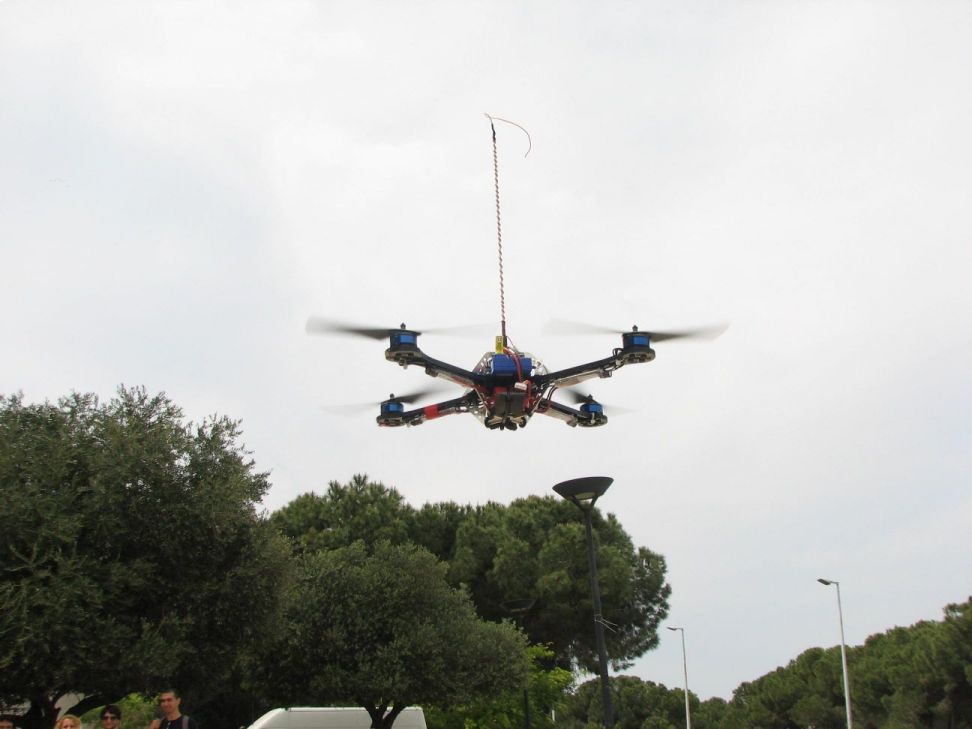The helicopter can be used for special missions, observations and surveillance

Students in the Faculty of Computer Science at the Technion built a "copter" - a tiny robotic helicopter that navigates, takes pictures and maneuvers independently. It can be used for special missions, observation and surveillance. This is how the Faculty Homepage newspaper reveals.
"Today, after several stages of development, we have reached a total weight of one kilogram, with a stay in the air of 30-40 minutes," says Ronen Kider, the engineer of the Laboratory for Intelligent Systems. "The drone can enter the building through the window, perform its work and come back out."
Prof. Ehud Rivlin, who leads the project on behalf of the faculty, noted that the students, under his guidance, contribute to the project in aspects of information processing and computer vision. "With the help of various sensors that we added to the drone, we give it the ability to distinguish obstacles and prevent collisions, maintain altitude and orientate in the environment with the help of a XNUMXD map."
At this stage the camera is in the belly of the "drone", but the Technion researchers are going to equip it with another camera so that it will be possible to take pictures forward and backward, and in fact in 360 degrees in the horizontal plane.
"Adding a PC Pocket handheld computer allowed us to increase the drone's processing capacity" adds Aral Uziel, a graduate of the Technion's Faculty of Computer Science, who participated in the development. "The computer controls the drone through a control box located on the platform and is responsible for the steering, thus enabling the drone to communicate wirelessly with a ground station to receive flight instructions and transmit location and transfer images while using the computational and communication capabilities of the handheld computer on it."
The project was led by Prof. Ehud Rivlin from the Faculty of Computer Science, Prof. Pini Gurfil from the Faculty of Aeronautics and Space Engineering, the engineer of the Laboratory for Intelligent Systems, Ronan Kidar and the hardware engineer Sergey Danilian. The project is funded by the Deborah Foundation and the Center for Autonomous Systems at the Technion.

8 תגובות
Olive Engineering is developing an aerial firefighting crane. It's a device that hangs from a long cable below a standard helicopter. The cabin includes flight control and stabilized nacelles. The helicopter hovers far above the building and the cell suspended by a cable clings to each floor of the building. The project was reviewed by the Home Front Command and the Ministry of Defense and received a document with a positive assessment. The Fire Commission also delivered a letter in which it gave a positive opinion to the purchase of this crane at the final stage of the development. The Olive Engineering company is in talks with the state to finance the development. About 8 million dollars is required to complete the development
Best regards
Nehemiah Cohen Menchal and aeronautics engineer
Nehemia@olive-eng.co.il
For the issue of high-rise rescue, there is the solution of a rescue cell from a rocket that is being developed by the Olive Engineering Company. See http://www.olive-eng.co.il
Kudos to all involved in the craft, the future of this product looks excellent
To refresh - I don't believe that rescuing people will be part of the features of the device, it weighs a total of 1 kilo
Photography and delivery service to kiosks seems more logical
To the people of the Technion,
Offer to sell it to Raphael, it will surely interest them.
fantastic!!!
It will have countless uses over time. The very fact that they managed to minimize the drone to a weight of 1 kg, and this probably with a low budget, means that there is a lot of potential here for civil but mainly military uses.
One of the most important of them is the ability to patrol and protect territories. When this miniaturization gains momentum and it will be possible to put explosives on the drone, it will be able to replace soldiers in an attack by building "suicide" drones that can home in and eliminate enemy soldiers/terrorists. It sounds inhumane, but such a battery of drones will be able to attack a target without Using soldiers, we will have to risk less.
It is good for rescuing people who are on the roof of a burning skyscraper, so that the specters of people jumping on September eleventh do not return.
to be sick with hummus.
Being familiar with the project, maybe you can satisfy my curiosity, how much noise does this drone make? strong ? weak?
Suggestion for the name: "The Freaky Drone" or for short Rahmah.
Know the project
But they finished it two years ago, it's strange that they are only now publishing it
I might add that this helicopter has a mechanism that it can't get stuck in things
Even if you work in manual mode and you come at top speed into a wall, the helicopter recognizes the wall and stops
Cool, waste of time